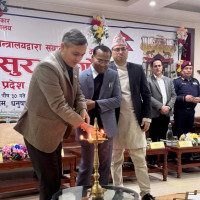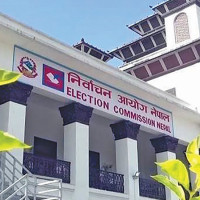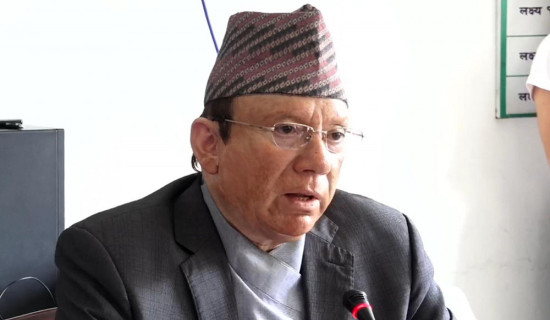- Wednesday, 14 January 2026
58thAnniversary Special Supplement
Implication Of Media’s Use Of AI Images
The last few weeks saw AI-generated images flood Nepali social media. Beautiful, awe-inspiring, and, depending on the prompt, eerily realistic, these images found many fans online. People hurried to AI-based platforms to see what they could get the algorithm to create. Some generated fantastical reimaginings of Nepali landmarks; others created enactments of religious stories and folktales; and others still presented humorous portrayals of food and drinks.
But then, as with AI-generated text before, people began using it for more “formal” purposes. Some of this scribe’s friends told him that they had used AI to develop images for academic reports and business presentations. Some media outlets also got in on the action and used AI to generate images to accompany their news.
However, the use of AI images in news perhaps raises questions about the broader implications this technology holds for journalism.
Now, it must be clarified that journalists and media can and should make use of new technology available to them. It helps them stay current, keeps their content fresh, and attracts readers, listeners, and viewers. An outlet that does not experiment stagnates and eventually dies out. Innovation brings success. However, AI is a divisive topic, and its potential benefits and drawbacks should be thoroughly researched before it is made part of the news production process.
First, the benefits. AI images reduce the costs involved in news visualisations. Previously, news organisations had to hire an illustrator or a photographer to get an appropriate image or photo for their reports and stories. They had to procure software and equipment (at least a camera and a computer). They had to spend a considerable amount of money. But now, journalists or editors can themselves create illustrations or photos using free-to-use services almost instantly.
But there is a caveat. While AI can create general photos, like two men shaking hands in a park, it cannot create specific photos. This is to say that if we need a photo of Prime Minister Pushpa Kamal Dahal ‘Prachanda’ meeting Nepali Congress President Sher Bahadur Deuba, we have to send a photographer to that meeting to click photos. AI is not yet able to create photographs of real people in real situations. So, as things stand now, artificial intelligence cannot fully replace photojournalism.
But AI tools can recreate historical events, visualise speculative scenarios, or illustrate abstract concepts that are otherwise difficult to represent. This expands the narrative potential of journalism, enabling media to deliver a more immersive and engaging experience to the audience.
And this brings us to the second benefit AI image generation offers media: efficiency. AI tools can quickly generate images based on text prompts, saving organisations time and energy. Media personnel do not need to think of images or photos to go with their reports; they can ask the illustrator or photographer to make or get them and wait for them to finish. Neither do media personnel need to subscribe to stock photo sites like Getty or Shutterstock. They can concentrate wholeheartedly on producing the best news they can and then get the AI to make an appropriate visual to go with them. There is no need for inter-departmental cooperation, reducing friction and delays. AI platforms allow journalists to run wild with their imagination, creating unique and appealing images that best convey the essence of their news and attract audiences.
But, despite these alluring benefits, the media’s use of AI-generated images also raises several concerns, with the main one being a question of authenticity. There is an understanding that mass media always presents reality. The news they present is factual, and the photos and videos they give are of things that actually exist. Using AI to create non-existent things can shake this foundation and shatter public trust in the media. The media can solve this by transparently disclosing their use of AI. A simple caption under a photo can go a long way. But not all media will care enough to be open about their sources. This will undermine the credibility of the whole industry.
All we need to do is think of the last time a politician or a prominent personality accused the media of Photoshopping images or editing their audio or video out of context. Imagine if they started accusing outlets of using AI. The journalists or the media may deny the allegation, but will we be able to fully believe them? With artificial intelligence blurring the line between reality and simulation, will we be able to say with 100 per cent confidence that the content we are being given is the truth, the whole truth, and nothing but the truth? These are the questions that will make people lose their faith in mass media. And speaking of transparency, can the media truly vouch for the way AI systems generate images? Can they even understand it? Let’s say an outlet takes a picture of a woman walking a dog, but somehow, the woman’s face resembles that of a person who passed away a few years ago. The deceased’s family is livid and demands answers. What would the outlet say? All it did was enter a prompt.
The same can be the case with copyright. What if the generated image matches a picture or drawing made by an artist? Will a media organisation be able to defend itself from accusations of plagiarism? AI image generators are sometimes called “black boxes” because it is difficult to understand how they generate images and what data they are based on. So, perhaps, it would be good for the media to tread the AI ground lightly.
It bears repeating that this article is not a condemnation of the use of AI by the news media. On the contrary, it acknowledges that it has the potential to revolutionise journalism and enhance storytelling. However, this article does ask the media to carefully consider the benefits and drawbacks and implement strong ethical frameworks to ensure AI images do not harm their and their peers’ credibility.
(Mishra is a journalist at The Rising Nepal.)




-square-thumb.jpg)








